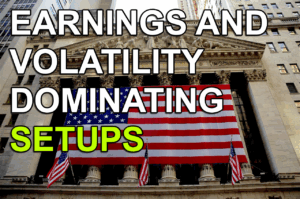Hi Everyone
Once in a while the markets give us what most traders fear the most … the dreaded outside bar! An outside bar occurs where today’s high is higher than the previous day’s (or days’) high, and Monday’s low was lower than the previous day’s (or days’) low.
In practical terms if you trade breakouts this is nasty if it’s occurred around a breakout area or flag as it can get you in and out in rapid succession and with a loss – ouch! This is what happened on Monday, and with the bar closing near the lows of the day, Tuesday saw a steep fall.
Fortunately, the way we trade, the loss on any outside bar will only be small.
Even more fortunately, with the OVI we have a world class indicator that helps us gauge market sentiment so we can be positioned on the right side.
In recent months I’ve been leaning more towards the Nasdaq (QQQQ) OVI readings. Since mid April these have been negative on the QQQQ and the market has been unmistakably negative. The S&P OVI has barely peaked above neutral, while the narrower based DOW has seen the OVI rise into positive territory, though it’s back below zero now.
In an ideal world you have all three major indices correlating. However, the DOW is the weakest of the three major indices for the OVI, so I tend to go with the S&P and the Nasdaq which are broader based and more heavily traded.
So, how do you read the general market?
Simple … I pay attention to the financial stocks like GS, and the S&P (SPY) and Nasdaq (QQQQ).
Remember, the OVI only measures trading activity. For real power, we combine it with specific chart patterns.
So, if I have a negative OVI and a consolidating chart pattern (like a bear flag, or a sideways channel) it’s likely that the breakout will occur to the downside. To protect ourselves, we ONLY activate our trade when the price breaks.
DOW (DIA) Chart:
The Dow OVI is very responsive and turned positive within 3 bars of the double bottom low bar. This is tradable above the breakout just over 103.50, however, you have to be mindful of the S&P and Nasdaq OVIs which weren’t responding quite so positively, so you’d need to have had tight stops in place.

S&P (SPY) Chart:
The S&P OVI tried and couldn’t quite get over the hump even with such a big upswing from the recent low of the double bottom. This is bearish.

Nasdaq (QQQQ) Chart:
The Nasdaq OVI never even got anywhere near zero and so the recent breakout failure hardly came as any surprise.

GS Chart:
GS, the bellwether of financial stocks is trying to get its OVI above zero but it’s not happening right now. If the stock can get above 140, 147, or even better, 150, with a positive OVI, then we could have a run. But for now, more likely is that we haven’t seen the lows.

More next week.
All the best
Guy
To learn more and have access to the OVI visit my Private Traders Club area.
Private Traders Club







